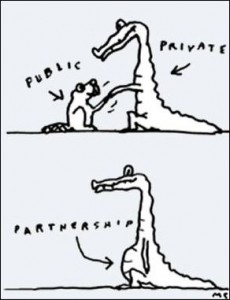 We haven’t heard much about Public-Private Partnerships since the days of the McDonnell administration, which touted P3s as a tool for leveraging limited state transportation funding into more road and rail construction. The problem with the McDonnell team’s reliance on P3s wasn’t the grand strategy but the execution. The tolling of the Downtown-Midtown Tunnel in Norfolk proved so controversial that the state felt compelled to cough up money to buy down the cost of the tolls. Also, the U.S. 460 Connector turned into a fiasco potentially costing the state $300 million, including $250 million in payments to the concessionaire to do nothing even though the U.S. Army Corps of Engineers had balked at issuing wetland permits for the proposed route.
We haven’t heard much about Public-Private Partnerships since the days of the McDonnell administration, which touted P3s as a tool for leveraging limited state transportation funding into more road and rail construction. The problem with the McDonnell team’s reliance on P3s wasn’t the grand strategy but the execution. The tolling of the Downtown-Midtown Tunnel in Norfolk proved so controversial that the state felt compelled to cough up money to buy down the cost of the tolls. Also, the U.S. 460 Connector turned into a fiasco potentially costing the state $300 million, including $250 million in payments to the concessionaire to do nothing even though the U.S. Army Corps of Engineers had balked at issuing wetland permits for the proposed route.
Trip Pollard, staff attorney with the Southern Environmental Law Center, has been one of the most outspoken critics of Virginia’s P3s. But in a recent post on the Brookings Institution blog, he says he sees them as a potentially valuable tool to supplement public funds with private capital. Rather than throw out the P3 option, he argues, we need to build more transparency, public input and government oversight into the P3 approval process. He offers several concrete suggestions.
Speaking of public engagement with P3s, here are the new “P3 Public Engagement Guidelines” released by the Office for Virginia Public-Private Partnerships. I’m not sure it’s possible to fully reconcile the private sector’s desire to negotiate in secrecy, not in the press, and the public’s right to know. But the McAuliffe administration is making a yeoman’s effort of trying to thread that needle.
Meanwhile, occasional Bacon’s Rebellion contributor Randy Salzman is still doggedly pursuing P3s. He asks a simple question: How is it possible that so many P3s have proven to be financial disasters, and why, knowing their abominable track record, do private-sector players continue to invest in them? Do the private participants engage in behind-the-curtain financial engineering that makes P3s profitable even if revenues fall short and the projects tank? He has come up with some tantalizing leads but no definitive answers. My suspicion: Follow the TIFIA loans, federally backed loan guarantees that absorb much of the risk inherent in P3 projects. What are the underwriting standards for those loans? How many have gone bad? How much in losses has the federal government sustained?
— JAB


